The nao bell, as a kind of musical instrument which gives out sound by beating the bell body to, is one of the oldest bronze percussion instruments that were put to use in China. Prevalent in the late Shang and early Zhou Dynasties, they have mainly been unearthed in southern Henan Province, southern Shandong Province and Guanzhong, Shaanxi Province. [1]

(1) overall height
(2) length of xian
(3) “middle-height” (zhonggao)
(4) length of handle
(5) ding (width and length)
(6) handle diameter at handle-body joint
(7) handle diameter at bottom end
(8) tai
(9) length of mouth
(10) space between bulging parts (gujian)
(11) thick wall
(12) mouth
(13) lips
Different parts of the nao bell [2]
As relevant archeological materials have indicated, nao bells made in the Shang Dynasty are mostly decorated with large squares in relief, similar to those found on bronze bells unearthed at Erlitou. However, the former is different in that the hollow cylindrical yong handle of the nao bell is connected with the cavity of the body. When the nao is used, a wooden handle is fitted into the hollow so that the instrument can be held or planted into the ground. Music is produced by beating the mouth of the nao with a mallet. The nao bell is a “zhiming” (lit. “planted”) musical instrument whose mouth faces upwards, whereas the bell is a “xuanming” (lit. “suspended”) musical instrument. In the Shang Dynasty, nao sets consisting three or five nao bells had appeared. They started to be used to play music [3]. As an early bronze article produced in the period when bronze instruments attained maturity, the nao inherited the traditional “flattened cylindrical” design of pottery bells in primitive times. Not only was the “joined-tiles” structure established, but also complete nao sets appeared. Moreover, the foundation was laid for the “one-bell-two-notes” design of bronze bells in the Zhou Dynasty. According to the analysis of the actual findings of archeological excavations, these bronze musical instruments have been unearthed only in a few large- and medium-sized tombs. Therefore, nao sets must have been ritual musical instruments exclusive to eminent nobles in that period.
After the Shang Dynasty, in areas beyond the Yin Ruins, nao sets became relatively rare. And the size of the instrument became increasingly larger. They could no longer be carried by the handle, but only be beaten while being planted in the ground. Therefore, big nao bells gradually started to be hung up when played. Around the mid Western Zhou Dynasty, the instrument completed its evolution into the bell that we know today.
Of the numerous bronze musical instruments made in the Shang Dynasty, the bronze nao should by no means be neglected or slighted. According to available materials, so far no less than 15 nao-involved discoveries have been made. If some of them were not stolen or broken, every nao set unearthed invariably comprises three or five nao bells (the only five-nao set was unearthed from Lady Fu Hao’s Tomb). [4]
In 1976, five well-preserved bronze nao bells were unearthed at Lady Fu Hao’s Tomb in the Yin Ruins located in Anyang City, Henan Province. Progressively smaller in size, they are basically identical in shape and design. Every nao is embellished with a meander-shaped bowstring design on the both sides and covered with green rust all over. The largest two bear a two-character inscription reading yajiang inside the cavity. [5]

In 1984, three bronze nao bells were unearthed at Tomb 269 of the Shang Dynasty at Qijiazhuang Village, Anyang City, Henan Province. Of the same shape and carrying the same design and inscription, they are progressively smaller in size. Their bodies are decorated with convex taotie (ogre-mask) motifs which are surrounded by convex bowstring motifs. On the front bulging part of each nao bell, there is a square tai, on one side of which the Chinese character ai (love) is inscribed.
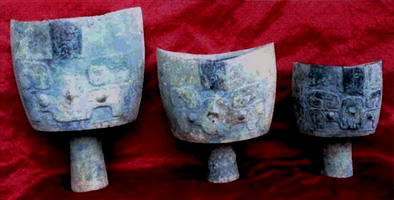

In 1982-1992, three bronze nao bells were unearthed at Tomb 160 at Guojiazhuang Village, Anyang City, Henan Province. Of the same shape and carrying the same designs, they are progressively smaller in size. Their bodies are decorated with convex taotie motifs. On the front bulging part of each nao bell, there is a square tai. On the interior wall of the bulging part, the pictographic character  is inscribed (characters hu and zhi within a ya-shaped frame); the lower part of the handle is slightly wider and inscribed with
is inscribed (characters hu and zhi within a ya-shaped frame); the lower part of the handle is slightly wider and inscribed with 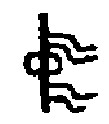 (zhong, or “middle”). [6]
(zhong, or “middle”). [6]
Bronze nao bells unearthed from Tomb 160 at Guojiazhuang Village in the Yin Ruins in Anyang, Henan Province
 |
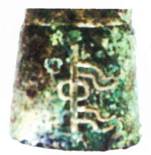 |
Inscription on the bulging part of a nao unearthed from Tomb 160
Inscription on the handle of a nao unearthed from Tomb 160
In 1968, three bronze nao bells were unearthed from Shang Tomb 8 at Subutun Village, Qingzhou City, Shandong Province. Of the same shape and carrying the same designs, they are progressively smaller in size. The hollow yong handle is connected with the cavity. At the bottom end of the handle, there is a band. The bodies are adorned with convex taotie motifs which are surrounded by convex bowstring motifs. On the front bulging part of the body there is a square tai,platform.
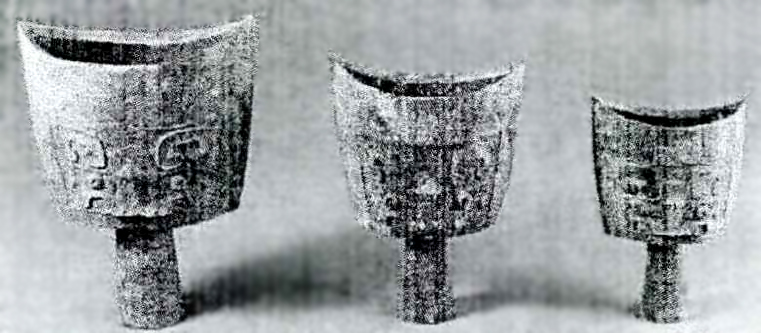

Bronze nao bells unearthed from Tomb 8 at Subutun Village, Qingzhou, Shandong Province
Judging by the above-mentioned several bronze nao sets, those made in the Shang Dynasty are generally small. Each set consists of nao bells that become progressively smaller and constitute a group of fixed-pitch instruments with certain tonal relations. The data acquired through tonal tests reveal that when Shang people designed and made bronze nao bells, they had already had some demands on rhythm and started moving towards music playing. The findings also show that nao sets were important royal ritual musical instruments prevalent in the late Shang Dynasty and they were of special importance in the royal court.
Why does a Shang Dynasty nao set always consist of an odd number of nao bells?
Reference answers: Some believe that it was because, in the Shang Dynasty, considerable progress had been achieved in mathematics and people could tell the differences between even and odd numbers and multiples; some think that it is an initial form of “embodying ceremony in articles”; other say that nao sets were specially designed to comprise an odd number of nao bells as a type of musical instrument.
Your answer please, if you have any questions or answer, please fell free to send us email, we are waiting for your answers and participation, and your comments, answers and suggestions will be highly appreciated. We will select and publicize the most appropriate answers and comments some time in the future.
Weekly Selection Email: meizhouyipin@chnmus.net
Finding out the Owner of the Bronze Nao Bells with Meander Pattern
This batch of bronzes unearthed at Xiaonanzhang, Wenxian County, Henan Province, was a very important discovery in Wenxian. When archeologists investigated the bronzes, they found that some of them bore the inscription of the Chinese character xi “徙”.
Among them there is a bronze gui. With an overall height of 17 centimeters, it has a slightly flared mouth with circular rim, a slightly slanting belly, and a relatively high ring foot. On the bottom of the container, the inscription of the character xi can be found.
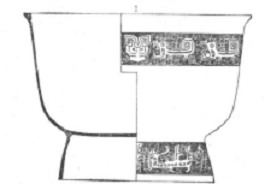
|
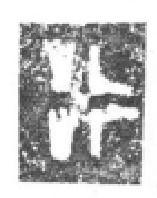
|
Bronze gui with the inscription of the Chinese character xi “徙” [7]
There is also a bronze jia (wine vessel). With a total height of 37.3 centimeters, it has a broad mouth, a round bottom, three triangular feet, and two ears. Its feet are decorated with kui-dragon motifs consisting of “cloud & thunder” and plantain-leaf designs. The interior wall of the container bears the inscription of the Chinese character xi.

|
Bronze jia and the inscription of the Chinese character xi [8]
There is also a bronze jue (wine vessel). With an overall height of 15.5 centimeters, it has a spout in the front and a tail at the back. The mouth is flanked by a pair of posts in symmetry. It has a round bottom and a handle. The inscription of the Chinese character xi is also found on the interior wall of the handle.

|
 |
Bronze jue and the inscription of the Chinese character xi [20]
According to archeologists’ study and evaluation, the Chinese character xi inscribed on this batch of bronzes, was probably the name of a clan, which held the post of “hunting official” at that time. This batch of bronzes could probably have been “xi’s possessions” (xiqi) [9]. Therefore, it can be speculated that the owner of this tomb in Wenxian, Henan Province, may have been an official from the xi clan, who was in charge of hunting.
Notes:
[1] MA Chengyuan. The Chinese Bronzes [M]. Shanghai: Shanghai Classics Publishing House, 2003:273.
[2] FANG Jianjun. A Tentative Study on Nao Sets of the Shang Dynasty Unearthed in Henan [J]. Musicology in China (Quarterly), 1990(3):68-73.
[3] GAO Menghe. Bronze Ware and Chinese Culture [M]. Shanghai: Publishing House of the Unabridged Chinese Dictionary, 2003:275.
[4] CHEN Quanyou. A Study of Exchange, Evolution and Development of Shang Music Culture in the Light of Unearthed Musical Instruments [J]. Musicology in China (Quarterly).1999(4):131.
[5] Institute of Archaeology of the Chinese Academy of Social Sciences. Report on the 1969-1977 Excavation of the Yin Ruins in Anyang [J]. The Chinese Journal of Archeology, 1979(1).
[6] Institute of Archaeology of the Chinese Academy of Social Sciences. Report on the 1982-1992 Archaeological Excavation of Shang Tombs at Guojiazhuang Village of the Yin Ruins in Anyang[J]. Encyclopedia of China Publishing House, 1998:70-125.
[7][8][9] YANG Baoshun. Shang Bronzes Unearthed in Wenxian County [J] Cultural Relics, 1975(2).
In August 1968, when farmers of the county town of Wenxian, Henan Province, were picking herbal medicines, they discovered a batch of bronze wares in a very shallow pit, which include this set of bronze nao bells. The three bronze nao bells, progressively smaller in size, are identical in terms of shape and design. When placed upwards, each of the instruments has a mouth outlined by two concave curves, a body shaped like “two tiles joined together” (hewa), a cavity with thick walls whose section looks like a broad leaf, two pointed xian corners at the top with a space slightly larger than their height, and a pipe-like short handle which becomes progressively thinner from the bottom end to its joint with the cavity. The hollow cylindrical yong (the name for the handle of the nao bell) is connected with the cavity. Each of the three nao bells is embellished with a trapezoidal dual-line bowstring design on both sides. The thick convex twin-lines form a design which look like the Chinese character hui, hence the name of the bell. These bells are typical Shang bronze articles.
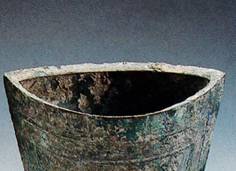
Mouth outlined by concave curves
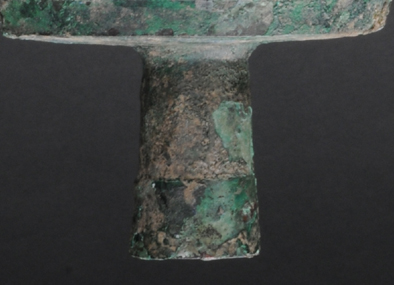
An acoustic study of the bronze nao bells has shown that, when beaten at their front bulging part, they respectively produce sounds of three notes, i.e., do, re and sol (or shang, jue and zhi, according to the traditional Chinese five-note scale). That is to say, the discovery of this nao set has constituted material evidence and scientific basis for studies of bronze musical instruments in the late Shang Dynasty, particularly bronze nao sets near the Yin Ruins. In addition, they have also fully demonstrated China’s bronze casting technology and consummate handicraft in that period.
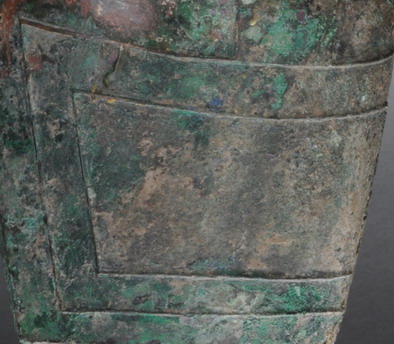

A set of three bronze nao bells with meander pattern, made in the Shang Dynasty, the overall heights are respectively: 20.5cm, 17cm and 14.5cm. In 1968, they were unearthed at Xiaonanzhang Village, Wenxian County, Jiaozuo City, Henan Province.

